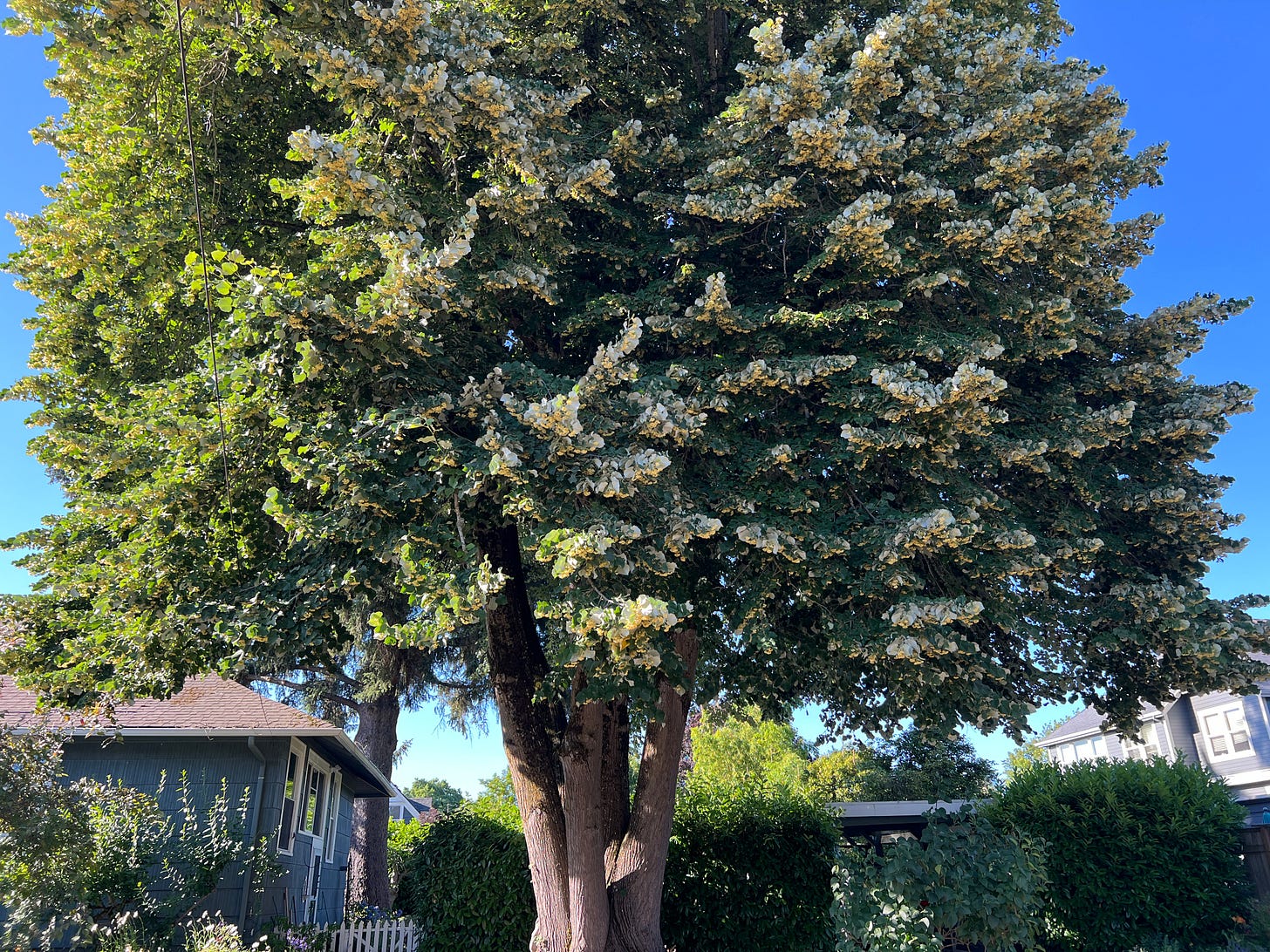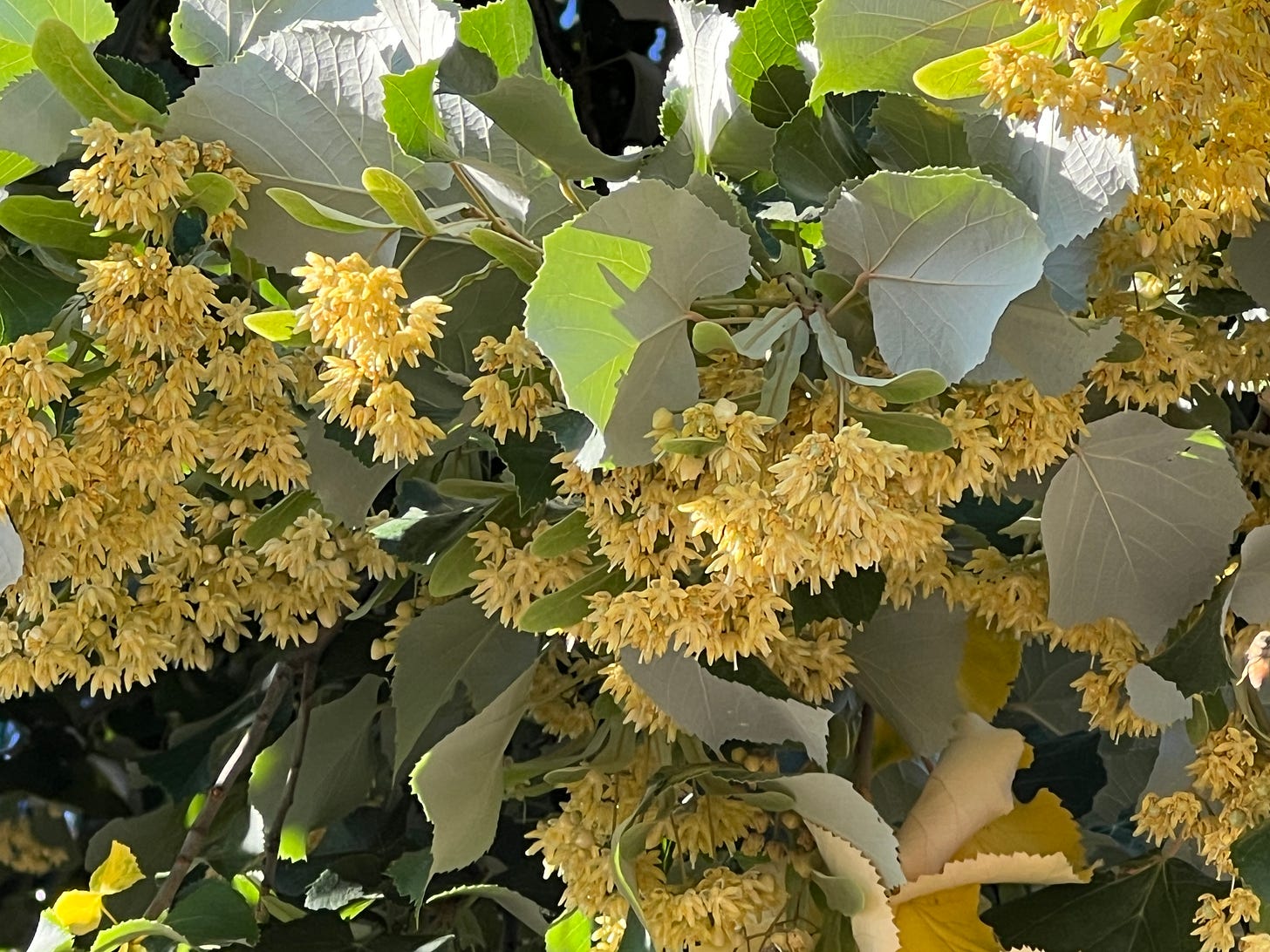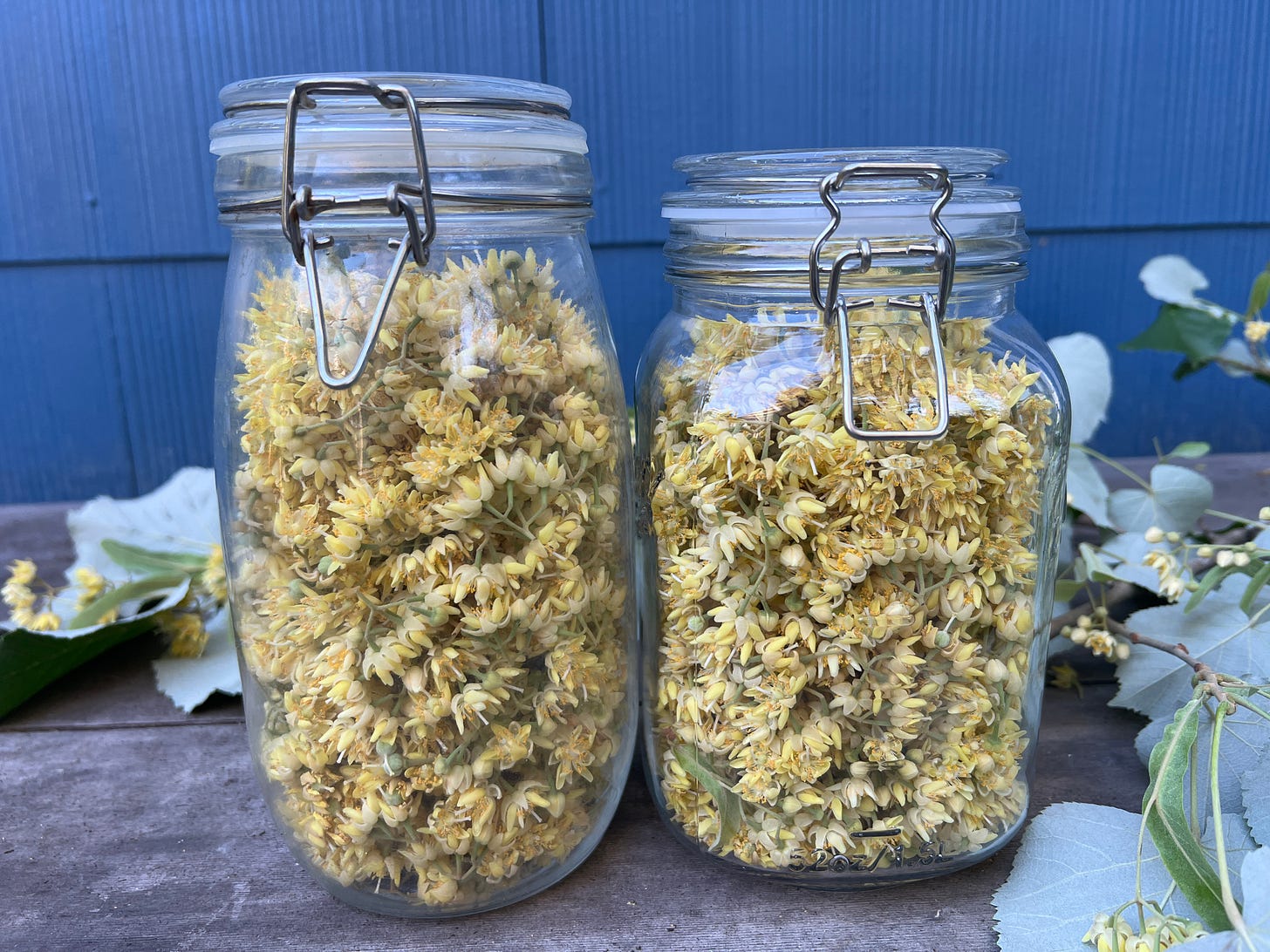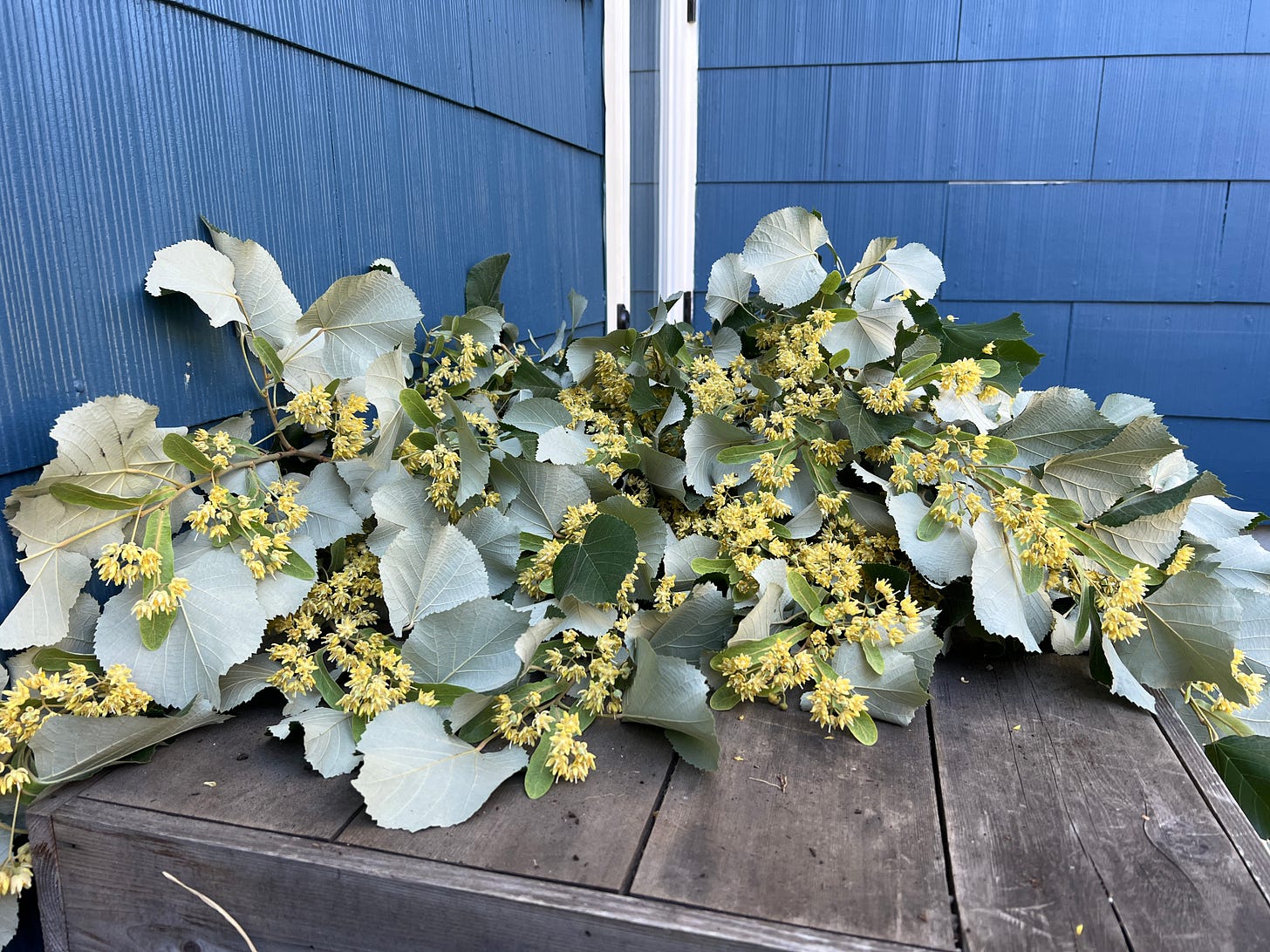This is the week I have been anticipating all year. Not just July 5, when summer traditionally hits in Portland and Seattle. No, this is the week when North Portland’s giant lindens erupt in scent, and when the foraging season gives way to gleaning.
There are multiple species of linden trees planted around town, and unfortunately, I can’t quite identify which are which. (Update: A reader just generated an interactive map of linden trees in Portland, which IDs the species.) I do know that the smaller (update: small-leaf!) lindens, which are earlier to bloom, give off a sweet, gentle scent that, as someone who went to junior high in the 1980s, reminds me of Sweet Valley High books and Love’s Baby Soft perfume.
The trees that mark the beginning of summer are, instead, the silver lindens along the south side of Peninsula Park. Just as I do each year, I’ve been taking daily bike rides and drives past the park, waiting for the lindens’ perfume to spill out into the street. It’s more of a heady, hothouse aroma, whose melodrama I love even though I love it most in passing. Bringing these linden flowers inside is like inviting a drag queen to belt out a few Dua Lipa numbers in the living room of your tiny home.
This year, it happened on Sunday, so I immediately messaged my neighbor Pamela.
Pamela has a towering silver linden in her yard that likely dates back to the 1910s, when Peninsula Park’s trees were also planted. For the past three summers now, she has let me come over at peak linden time to snip off a few branches. (It’s probably 60 or 80 feet tall. No one misses them.) In 2022, I dried the flowers to make thé de tilleul, or linden tea. Last year, when I posted something about linden flowers on Instagram, the brilliant chef Cortney Burns DMed me with a suggestion: Why don’t I steep the blossoms in vodka to make linden liqueur?
The day I got Cortney’s message I rushed over to Pamela’s house to grab a few branches (thanks again!), snipped off the flower clusters, and filled a jar with them. We don’t keep vodka around the house, so I asked the clerk at our neighborhood liquor store to recommend something local I could use for an infusion. The cheaper the better, he replied, and pointed out a plastic bottle of Rose City Vodka. It’s higher-quality than you’d think.
I poured the vodka over the flowers, then let the infusion sit for three days until I tasted a few drops and the smell of linden filled my nose. (In this case, a longer infusion wouldn’t be a better one — I just wanted to extract the floral aromas, without tainting the infusion with bitter, tannic, or overly vegetal notes.) Then I strained the vodka and added enough simple syrup until the results tasted delicately sweet but not overpowered by sugar. (How much simple syrup? I didn’t measure it. If you’re repeating my experiment, add syrup in half-cup amounts and taste as you go.)
Wow, was cheap vodka not the right move. When I sniffed the final mix, the spirits’ cleaning-fluid smell scoured its way through my sinuses. Then I poured the liqueur over ice, let the ice melt a little to water the liqueur down, and took a sip. It was as if I had pinned a linden garland to my hair. Every time I inhaled, a passing whiff of flowers greeted me. With each sip, the floral note faded and a delicate, green, cucumber flavor emerged.
Christian and I fell in love with sipping the liqueur over ice as an aperitif on warm nights. I kept thinking I’d mix up a cucumber-linden spritz for a party, but by the end of summer, the test bottle was empty.
Last night, I gathered enough branches from Pamela’s tree to fill two 1.5-liter jars. This year I semi-splurged on a jug of Reyka Vodka, which seemed to get high marks from online reviewers for its clean, neutral flavor at a reasonable price. Now we wait until the weekend to see whether I’ve improved on last year’s batch.
During late winter and spring, my little quest to eat the neighborhood feels more like a selfish pursuit. Whether I’ve gathered waterleaf from the park, wild pea shoots from the roadside, or grape leaves and bittercress from my yard, spring foraging is all about gathering the newest, most delicate sprouts and flowers while they’re tender and palatable. I’m too lazy to spend hours scouring the neighborhood for bushels of wild greens to give away, so I make tiny salads instead, or enough dolmas for a single meal. Spring’s found-food cooking feels like small acts of gratitude.
Summer, though, is the moment when nature gives us too much. When our yards and garden beds beg us to gather the harvest NOW, cook it NOW, and give away more than we can keep. A time when a single 80-foot-high linden tree can blanket the surrounding blocks in its scent, and when just a few branches are enough to cover my garden table in flowers.
I’m writing this issue in a rush, letting you Portlanders know that if you want to make silver-linden liqueur, you’ve got to do it this weekend, when the blossoms have just opened and their aromas still cling to the petals. Our infusion jars are sitting on our kitchen counter, the flowers leaching their color and perfume into the spirits. If I get it right this year, I’ll finally have enough linden flower liqueur to give away.









Queen Victoria would like a NSFW word with you:
https://www.youtube.com/watch?v=aoqlYGuZGVM&t=3s
I would argue that your gift to the rest of us is your stories about what you forage, not the foraged foods themselves. Which means that you are not being selfish at all...totally generous!